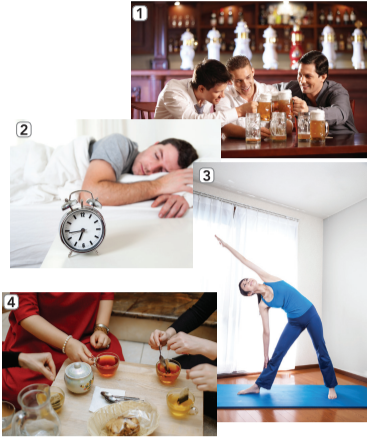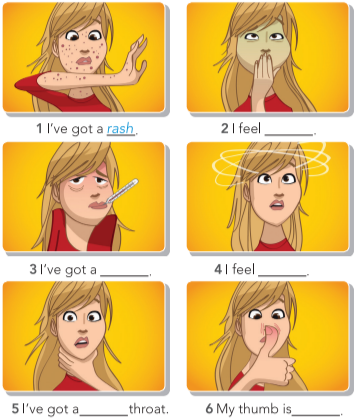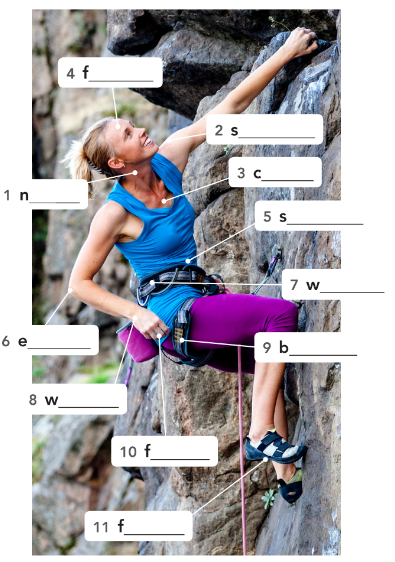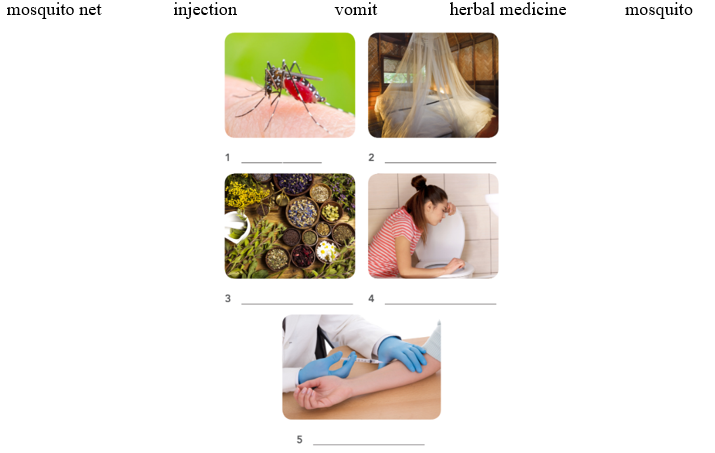Giải SGK, SBT Unit 2. Get well English Discovery
Giải SGK, SBT Unit 2 English Discovery
1. Look at the photos of six celebrities and read the text. In which photos can you see the parts of the body in the box?
(Xem ảnh của sáu người nổi tiếng và đọc văn bản. Trong những bức ảnh nào bạn có thể nhìn thấy bộ phận của cơ thể trong hộp?)
|
ankle calf eyebrows jaw knee lips thumb thigh |

1. Study the table about life expectancy in top 5 countries in 2019. Answer the following questions:
(Nghiên cứu bảng về tuổi thọ ở 5 quốc gia hàng đầu năm 2019. Trả lời các câu hỏi sau)
|
# |
Country (Quốc gia) |
Life Expectancy (both sexes) (Tuổi thọ - cả hai giới tính) |
Females Life Expectancy (Tuổi thọ nữ) |
Males Life Expectancy (Tuổi thọ nam) |
|
1 2 3 4 5 |
Hong Kong Japan Macao Switzerland Singapore |
85.29 85.03 84.68 84.25 84.07 |
88.17 88.09 87.62 86.02 86.15 |
82.38 81.91 81.73 82.42 82.06 |
1. Which country had the highest life expectancy for both genders?
2. Which country had the highest life expectancy for men?
3. Which country had the highest life expectancy for women?
4. Which country had the lowest life expectancy for both genders in the table?
3. Read GRAMMAR FOCUS I and answer the questions.
(Đọc NGỮ PHÁP TRỌNG TÂM I và trả lời các câu hỏi.)
1. Are the example sentences about real or imaginary situations?
2. Are they about the present / future or the past?
3. Do you have to begin a conditional sentence with if?
|
GRAMMAR FOCUS I (NGỮ PHÁP TRỌNG TÂM I)
Second Conditional (Câu điều kiện loại hai) You use the Second Conditional to talk about the present or future result of an imaginary situation. (Bạn dùng Câu điều kiện loại 2 để nói về kết quả hiện tại hoặc tương lai của một tình huống tưởng tượng.) imaginary situation => result (tình huống tưởng tượng => kết quả) If + Past Simple, subject + would ('d) / wouldn't + verb (If + Quá khứ đơn, chủ ngữ + would ('d) / would not + động từ) If I burnt my hand, I'd hold it under the cold water tap. (Nếu tôi bị bỏng tay, tôi sẽ đặt nó dưới vòi nước lạnh.) I'd put ice on the sting if I didn't have any tablets. (Tôi sẽ chườm đá lên vết đốt nếu không có thuốc.) |
3. Read the LANGUAGE FOCUS and complete the example sentences. How do you say the sentences in your language?
(Đọc NGÔN NGỮ TRỌNG TÂM và hoàn thành các câu ví dụ. Làm thế nào để bạn nói những câu sau trong ngôn ngữ của bạn?)
|
LANGUAGE FOCUS Clauses of purpose • You can use a to infinitive to say why somebody does something. You can also use in order (not) to or so as (not) to in a more formal style. • You can use an app to track 1 _______ Professor Turner carries out research in order to understand 2_______ You should go to bed at the same time every night so as not to upset 3_______. • You can also use so that + subject + verb. Your body temperature needs to drop by one degree Centigrade so that 4_______ |
1. Read the announcement in an international students' magazine. In pairs, discuss the questions.
(Đọc thông báo trên một tạp chí dành cho sinh viên quốc tế. Theo cặp, thảo luận các câu hỏi.)
1. What do you think are the advantages and disadvantages of being a doctor or a nurse?
(Bạn nghĩ những điểm lợi và bất lợi của việc trở thành bác sĩ hoặc y tá là gì?)
2. Who would you choose to write about? What would you mention in your article?
(Bạn sẽ chọn viết về ai? Bạn sẽ đề cập đến điều gì trong bài viết của mình?)
|
This week's profile: the medical profession (Hồ sơ tuần này: nghề y) As you know, every week we publish articles about people in different professions and this week it's the turn of the medical field! So, if someone in your family or someone you know is in the medical profession, we'd like you to send us an article and tell us something about him/her. (Như bạn đã biết, mỗi tuần chúng tôi đăng các bài viết về những người thuộc các ngành nghề khác nhau và tuần này đến lượt lĩnh vực y tế! Vì vậy, nếu ai đó trong gia đình bạn hoặc ai đó bạn biết làm trong ngành y tế, chúng tôi muốn bạn gửi cho chúng tôi một bài viết và cho chúng tôi biết điều gì đó về anh ấy/cô ấy.) |
4. Complete the sentences with the words and phrases from the box.
(Hoàn thành các câu với các từ và cụm từ trong hộp.)
|
as well as but in my opinion so |
1. She studied medicine in London. She also studied in Paris.____________ this, she studied for a year in New York.
2. I think she's the best doctor in the hospital. ____________ she should get a promotion!
3. The medicine was expensive, ____________ he still bought it.
4. Because visiting hours at the hospital finished at 4.30, we couldn't see my mum. It was getting dark, ____________ we took a taxi home.
You have seen this announcement about an article writing competition on an international students' website.
(Bạn đã thấy thông báo này về một cuộc thi viết bài trên trang web của sinh viên quốc tế.)
|
Who's your favourite health advisor? (Cố vấn sức khỏe yêu thích của bạn là ai?) We are looking for articles about people's favourite health advisor. Write about someone who has helped you or people around you improve your/ their health. (Chúng tôi đang tìm kiếm các bài viết về cố vấn sức khỏe yêu thích của mọi người. Viết về ai đó đã giúp bạn hoặc những người xung quanh bạn cải thiện sức khỏe của bạn/họ.) |
Write the article in 150-180 words. Include useful language below. Then use the checklist to edit your writing.
(Viết bài viết trong 150-180 từ. Bao gồm ngôn ngữ hữu ích dưới đây. Sau đó, sử dụng danh sách kiểm tra để chỉnh sửa bài viết của bạn.)
|
Useful language The person I've chosen is.... (Người tôi đã chọn là....) Her / His work involves.... (Công việc của cô ấy/anh ấy liên quan đến....) She/he is interested in.... (Cô ấy / anh ấy quan tâm đến ....) Some of her/his useful advice include... (Một số lời khuyên hữu ích của cô ấy/anh ấy bao gồm...) I wish I could do like her/him! (Tôi ước tôi có thể làm như cô ấy / anh ấy!) |
2. Complete the SPEAKING FOCUS with ONE word.
(Hoàn thành TRỌNG TÂM NÓI với MỘT từ.)
|
SPEAKING FOCUS Symptoms I've got a pain in my chest/back/leg. I've got a headache / a stomach ache / a temperature / a sore throat/ a cough / a runny nose / a rash. I feel ill/dizzy/sick/ very weak. My stomach/arm/neck hurts. My ankle/thumb/toe is swollen. Diagnosis When did the pain start? I'm going to examine you / 1take your temperature. I'm going to 2______ a blood test. Breathe in and out. 3______wide. Lie down, please. I think you've got indigestion/flu / an infection / a virus. You're probably allergic to ... If I press here, does it hurt? Treatment You should eat more slowly / go on a diet. You need to drink more water. I'm going to 4______ you a prescription. I'm going to 5______ an appointment for you. 6______ one tablet after each meal. |


















